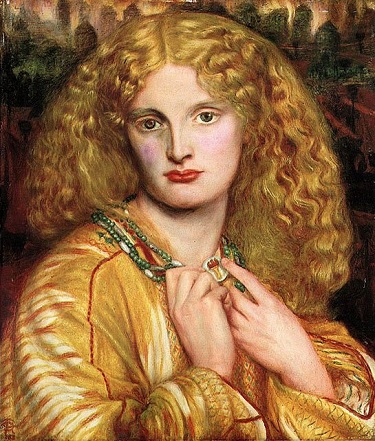
Women poets have struggled throughout history with the predominant male discourse, which labeled and stigmatized women from a patriarchal perspective. In their feminist iconic work, The Madwoman in the Attic (1979), Sandra Gilbert and Susan Gubar have determined that this prevalent male voice identifies women with the “eternal types” of “angel” or “monster”; accordingly, women writers are entangled in a prejudiced paradigm in which they “must examine, assimilate, and transcend” these absolute female models (17).
This essay will analyze and demonstrate how even relatively contemporary women poets from the twentieth century – Sara Teasdale, Hilda Doolittle (H.D.) and Margaret Atwood – still grapple with the patriarchal branding of women in their different renditions of one of the most famous female figures in literary history, Helen of Troy.
Sara Teasdale’s “Helen of Troy”
The Pulitzer-winning Sara Teasdale was a bestselling poet at the beginning of the twentieth century, publishing several successful collections of poems between 1907 and 1917. Even though she was not associated directly with any known feminist groups or movements, she does offer a uniquely feminine perspective and voice in her poetry as “[r]eviewers found the feminine point of view in her work to be one of its chief points of interest – a revelation of women’s emotion” (Drake, 1989). One such poem in which she evokes a unique feminine point of view is “Helen of Troy” from her collection Helen of Troy and Other Poems (1911).
In spite of the portrayal of the first-person speaker Helen in “Helen of Troy” as an intelligent, knowledgeable, highly conscious and conscientious woman, womanhood is nonetheless condemned for all the suffering and misery of the Trojan War, and thus she is inescapably rendered as the “monster” responsible for the consequences of this terrible war.
When Helen bemoans that the gods made her “wreak their wrath” because her “maidenhood” inflicts “[s]orrow and blood about” her (lines 7-9), it is a harsh denunciation of her ruinous femininity and beauty, without mentioning the men who actually decided to take up arms; she later extends this censure to another woman – Leda, her mother (20) – to whom she attributes “the beauty” and “the bale” (21). Helen continues to indict only her own feminine beauty and not men for the war by reiterating that it is “fate that made men love my mouth” (41) and that “[m]en’s lives shall waste with longing after” her because she “shall be the sum of their desire” (50-51) as if men simply have no other choice but to fight and kill because of her. Finally, she references the king of Sparta, Menelaus, whom she “wronged” and now “comes with sword to slay” (64-65); yet, even after all the bloodshed and the killing, he will not be able to resist her beauty and “shall not slay” her (66), but he “he shall cry” and take her “back to Sparta on his breast” (71-72).
Thus, despite her attempts to make Helen a more sympathetic character, Sara Teasdale still maintains Gilbert and Gubar’s dichotomy.
Hilda Doolittle’s “Helen”
Hilda Doolittle (H.D.) was born in the late nineteenth century and is one of the most prominent women poets of the twentieth century, mostly known for her involvement in the Imagist movement. In addition to Imagism, H.D. was also interested in psychoanalysis and modernism, all three of which are embodied in her poetry from a feminine perspective. Susan Gubar refers to this “twentieth-century trinity” of H.D. and states that “each is profoundly affected by H.D.’s sense of herself as a woman writing about female confinement specifically the woman writer’s entrapment within male literary conventions” (Gubar, 1979). This sort of female confinement and entrapment is manifested in H.D.’s poem about Helen of Troy from 1924, “Helen.”
The poem “Helen” presents a hyperbolized patriarchal view of Helen, brimming with raving rancor against her almost impossible to comprehend, and therefore generates the opposite effect of shedding doubts of irony over this masculine stance.
The first lines of the first and second stanzas begin with an anaphoric repetition of the phrase “All Greece,” followed by verbs that express absolute dislike, “hates” and “reviles”; This unfounded generalization of adopting a masculine hatred of one woman by the entirety of Greece creates sympathy ironically toward the isolated and lonesome Helen. Furthermore, the speaker of the poem utterly objectifies Helen by reducing her to body parts – “eyes,” “face,” “hands,” “feet,” and “knees” – which again compels on the reader an exaggerated masculine point of view on the verge of misogyny, and thus produces an inverse sentiment of compassion toward Helen. In the third stanza, the speaker alludes to the birth of Helen by stating that she is “God’s daughter, born of love” (13); according to Greek mythology, the conception of Helen resulted from the rape of Leda by Zeus, who disguised himself as a swan, and hence the speaker’s statement is so absurdly misogynistic that it can only be read ironically. The poem ends with the cruel assertion that Greece could only love Helen once her “white ash” is laid “amid funereal cypresses” (16-18), and the harsh viciousness of this grand finale obliges the reader to question whether or not the sheer acrimonious detestation of Helen is really justified.
Yet, although the poem does acknowledge through irony the irrational hatred toward Helen – and arguably toward women in general – it does not absolve Helen, ironically or otherwise, from the horrible acts committed exclusively by men according to the Greek myth of Troy. Helen’s own perspective is present in the poem only from the subjective perspective of the speaker, who imagines Helen “remembering past enchantments / and past ills” (10-11) – presumably Helen’s enchantments of men such as Menelaus and Paris, and the dire ills that ensued these enchantments.
H.D.’s “Helen” therefore uses irony in order to build empathy and compassion toward Helen, and in that regard, it is certainly much more feminist than most other texts that had been written about Helen until then, and accordingly, it demonstrates a certain deviation from Gilbert and Gubar’s binary definition. But H.D. still retains in this poem a small inherent patriarchal position when she does not go all the way and indict the men in Helen’s life for the pain and suffering of the Trojan War.

Margaret Atwood’s “Helen of Troy Does Countertop Dancing”
The award-winning Canadian writer Margaret Atwood is one of the most distinguished living writers nowadays who published many famous novels, poems, essays, and social activism texts. Even though Atwood is regarded generally as a feminist – there are entire books celebrating feminism in her novels, such as Margaret Atwood: A Feminist Poetics (1984) and Margaret Atwood: Feminism and Fiction (2007) – she herself refuses to define herself (Akbar, 2009):
“Feminism is a big term. If we are asking ‘Are women human beings?’ we don’t need to vote on that. But where do we go from there? Are women better than men? No. Are they different? Yes. How are they different? We’re still trying to figure that out.”
This sort of “still figuring out” feminism is evident in Atwood’s 1996 poem, “Helen of Troy Does Countertop Dancing.”
The speaker in “Helen of Troy Does Countertop Dancing” is a present-day Helen who works as an erotic dancer or a stripper. Even though this sort of job is one of the clearest manifestations of sexism, Helen is not ashamed nor embarrassed, but rather, she fully embraces her vocation.
In the first seventeen lines of the poem, she explains how other women tell her that she “should be ashamed of [herself]” (line 2), that she should get “some self-respect / and a day job” (4-5), that she should be “[s]elling gloves, or something” (12) and that she is “[e]xploited” (17); yet, she confidently declares that she has “a choice” and that she will “take the money” (18-19). Helen seems to take pride in her line of work and states that “[l]ike preachers, [she] sell[s] vision” (21), but she is not naïve at all – she understands that she is objectified and that there is a lot of misogyny around her. In fact, she proudly objectifies herself by listing her own body parts as men see her – “thigh, ass, inkblot, crevice, tit, and nipple” (29) – just before they realize that everything is “still connected” (30) and consequently, “[s]uch hatred leaps in them” (31). She goes on with a dreary masculine description of how men imploringly gaze at her as “survivors … / looking for garbage” (46-47) in “a looted city” after “all the rape’s been done / already, and the killing” (43-45). Helen proclaims that she does not open up to any man, and just those who believe that her “mother was raped by a holy swan” (61) – referencing and perpetuating the patriarchal myth of Leda and Zeus – she will allow to take her “out to dinner” (62).
Helen distills the essence of her approach in her claim that even though men would “like to see through” her, “nothing is more opaque / than absolute transparency” (73-75) – instead of fighting the dominated masculine culture, she creates a proud individual feminine identity upon it. When Helen ends with the warning to men, “Touch me and you’ll burn” (83), this is also a subtle allusion to Paris: according to some versions, such as Herodotus’s Histories, Helen did not go willingly with Paris to Troy but was abducted by him, which of course ultimately led to the eventual destruction of Troy.
Atwood chooses a very controversial style in her adaptation of Helen that at least partially is close to the positions of third-wave feminism, which acknowledges the power of feminine sexuality and “redefine[s] women and girls as assertive, powerful and sometimes promiscuous” (Brunell, 2008). However, this method can easily backfire by being misconstrued as sexist or by plainly being rejected and subsequently falling into the classification of Gilbert and Gubar.
In conclusion, the iconic figure of Helen of Troy still occupies twentieth-century female writers who wield this feminine symbol of beauty in different manners. Yet, in spite of the varied, brilliant portrayals and representations of Helen by these renowned female writers, they still strain to depict a female character from a completely liberated feminine perspective within a prevailing patriarchal culture and conventions.
There has certainly been feminist progress in the past hundred years, but Gilbert and Gubar’s work is, unfortunately, still relevant today as it is expressed in poetry as well as in too many other fields.
Works Cited
Brunell, Laura. “Feminism Re-Imagined: The Third Wave.” Encyclopedia Britannica Book of the Year 2008, p. 197. Chicago: Encyclopedia Britannica, Inc. 2008.
Drake, William. Sara Teasdale: Woman and Poet, 149-151. Univ Tennessee Press, 1989.
Gilbert, Sandra M., and Susan Gubar. The Madwoman in the Attic: The Woman Writer and the Nineteenth-Century Literary Imagination, 16-22. Yale University Press, 1979.
Gubar, Susan. “The Echoing Spell of H.D.’s Trilogy” in Shakespeare’s Sisters: Feminist Essays on Women Poets, 201-202. Vol. 263. Indiana University Press, 1979.



